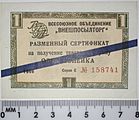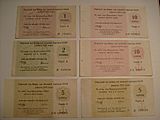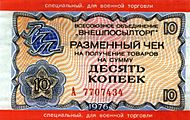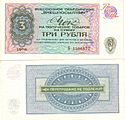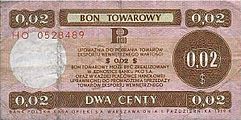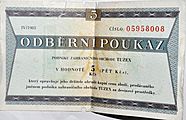Foreign exchange certificate facts for kids
Imagine a special kind of money that some countries used to control how people bought things from other countries. This special money is called a foreign exchange certificate, or FEC for short. Countries used FECs when their own money couldn't easily be swapped for money from other countries. Each country had its own rules for how these certificates worked.
Contents
Different Kinds of FECs
There were a few main ways foreign exchange certificates were used:
Special Tickets for Foreign Money
One type of FEC was like a special ticket. You needed it to buy money from other countries. This was often for a specific reason, like buying goods from abroad. Many European countries used these after World War II.
Special Money for Visitors
Another type of FEC was used by foreign visitors. They had to use these special certificates for some or all of their shopping. Sometimes, visitors got a better exchange rate with these certificates. The goal was to make sure foreign money went to the government, not to illegal markets. Germany used these from 1931 to 1948, and China from 1980 to 1994.
Certificates for Local Citizens
Some countries made their own citizens exchange any foreign money they received for these certificates. This could be from their salary or from family living abroad. These certificates could then be used in special stores. These stores often sold goods that were usually only available to foreigners using foreign money. The Soviet Union used this type of FEC between 1961 and 1989.
Money for Special Areas
FECs were also used in closed economic zones. An example is the Svalbard ruble for workers in coal mines. The idea was to stop too much money from outside flowing in. This helped prevent shortages of goods in these special areas.
Countries That Used FECs
Many countries have used foreign exchange certificates at different times. Here are some examples:
FECs in Local Money with Special Rules
These certificates were in the country's own money but had special rules for how they could be used or exchanged.
- Soviet Union: They had Torgsin cheques in the 1930s. Later, from 1961 to 1991, they used various FECs. The Vneshposyltorg cheques were very common.
- China: Used FECs from 1980 to 1994.
- East Germany: They had forum cheques. These were linked to the West German D-Mark.
- North Korea: They used separate certificates and tokens. Some were for "socialist visitors" and others for "capitalist visitors." This happened between the 1970s and 2008.
- Cuba: From 1985, several different FECs called INTUR cheques were issued. Later, the US dollar was allowed, along with the convertible peso.
- Czechoslovakia: They used Tuzex certificates.
- Bulgaria: They had Balkan Tourist, Corecom, and People's Bank of Bulgaria cheques.
- Communist Romania: Used NAVROM cheques.
- Vietnam
- Communist Albania: It was against the law to exchange these for regular Albanian lek banknotes.
- Yugoslavia: They used Putnik cheques in the 1950s. In the 1980s, they had People's Bank of Yugoslavia cheques.
FECs in Foreign Money
These certificates were usually in US dollars or another foreign currency.
- Myanmar (Burma): Used FECs until March 2013.
- Poland: They had Bon Towarowy PeKaO.
- Zimbabwe: Used Zimbabwean bond notes and Zimbabwean bond coins.
Other Special Money Rules
Some countries had other special rules for their money, not always called FECs.
- Ghana: Around 1980, it was illegal to bring Ghanaian cedi banknotes into or out of the country.
- Weimar Republic and Nazi Germany: Had special rules for currency from 1931 to 1948.
Images for kids


